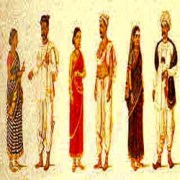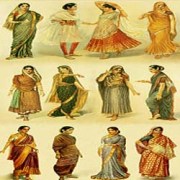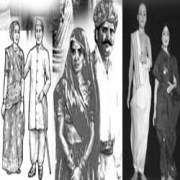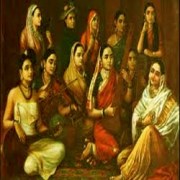Ancient Indian Clothing
 The index of human development can also be pegged with the clothing of the people during a certain time frame.
The index of human development can also be pegged with the clothing of the people during a certain time frame.
The remnants of the ancient Indian clothing can be found in the figurines discovered from the sites of the Indus valley civilization, the rock cut sculptures, the cave paintings, and human art forms found in temples and monuments.

Ancient Indian clothing The story of Indian clothing becomes clearer after recorded history developed in India. The recorded history of Indian clothing goes back to the 5th millennium BC, starting the Vedic times.
The court historians, foreign travellers, accounts of seers and sages when pieced together give a vivid pictureof the ancient Indian clothing.
Indian Clothing in Indus Valley Civilisation
The terracotta figurines from the Indus Valley Civilisation indicate that cotton was spun, woven and dyed. This is corroborated by the bone needles and wooden spindles that have been unearthed at the excavation sites of the Indus valley civilization.The Indus civilisation also knew the process of silk production. Recent analysis of Harappan silk fibres in beads have shown that silk was made by the process of reeling, the art known only to China till the early centuries AD.
Textiles made of wool finds mention in the Vedic text with reference to Kashmir. The Rig Veda refers to the Valley of Sindh as being abundant in sheep, and the god Pushanis addressed as the 'weaver of garments', that evolved into the term pashm for the wool of that area. Woollen shawls have been mentioned in Afghan texts of the 3rd century BC.
Most of the present knowledge of ancient Indian clothing comes from rock sculptures and the paintings in caves and other monuments. These images show human figures wearing clothes that appear to be wrapped or tied around the various parts of the body. From the Sari to the turban and the dhoti, ancient India clothes were mostly wrapped around in various ways.

Cloth tied around Body The sari was worn with a breast-band tied with a knot at the back. Even children just wore a piece of cloth tied around the waist with strings.
Both men and women wore ornaments. Early ornaments were mostly made of terracotta beads or shells strung together till metals came on the scene. Jewellery like necklaces, bangles and earrings were common. The use of flowers as ornaments was also common.The cave paintings suggest the use of coloured makeup. The forehead hands and palms were decorated with colour.
Indian Clothing in Maurya and Gupta Period
During the Maurya and Gupta period, the people continued to wear the three pieces unstitched clothing as in Vedic times. The main items of clothing were the Antariya made of white cotton or muslin, tied to the waist by a sash called Kayabandh and a scarf called the Uttariya used to drape the top half of the body. The upper castes dressed themselves in fine muslin and wore gold ornaments.
The cotton industry was well developedin ancient India. Herodotus the Greek historian who lived in the fifth century BC, describes Indian cotton as "a wool exceeding in beauty and goodness that of sheep".
A variety of weaving techniques were practiced in ancient India. Chanakya's treatise on public administration, the Arthashastra written around 3rd century BC, briefly describes the norms followed in silk weaving.Silk and cotton were woven into various designs and motifs, each region developing its distinct style and technique. Famous among them were the Jamdani, Kasika,butidar and Ilkal.

Men and women ornaments Roman historian Arrian’sin his work Indica described that Indian cotton clothing was well adapted to the dry, hot summers of the subcontinent. According to Arrian, who lived in the 2nd-century, Nearchus(360 - 300 BC) who was one of the officers in the army of Alexander the Great and had come to north-western India on thisexpedition describes about Indian clothing as follows:
"The Indians use linen clothing, made from the flax taken from the trees and are white in colour.
They have a linen frock reaching down halfway between the knee and the ankle, and a garment which is partly thrown round the shoulders and partly rolled round the head. Indians who are very well-off wore earrings of ivory; but most of them do not wear them at all. Indians dye their beards various colours; some may appear white as the whitest, others dark blue; others have them red, purple, and even green.
Those who are of any rank have umbrellas held over them in the summer. They wear shoes of white leather, elaborately worked, and the soles of their shoes are many-coloured and raised high, in order that they may appear taller."
Ancient Indian Clothing in Indo-Greek Period
As new trade routes, both overland and overseas, created a cultural exchange with Central Asia and Europe, there was more development seen in Indian clothing. Trade with China via the Silk Road introduced silk textiles into IndiaEvidence from the 1st century AD suggest some cultural exchanges with the Greeks. Romans bought indigo for dyeing and other items of clothings.
Indo-Greek Indo-Greek influence is seen in the Greco-Buddhist art of the time. The statues of Buddha were portrayed as wearing the Greek himation, which is the forerunner of the modern saṃghāti that forms a part of the Kasaya of Buddhist monks.
Dyeing of clothes in ancient India was practised as an art form. Five primary colours were identified and were categorised by their many hues. The ancient treatise, Vishnudharmottara states five to ones of white, namely Ivory, Jasmine, August moon, August clouds after the rain and the conch shell. The commonly used dies were indigo (Nila), madder red and safflower. The technique of mordant dyeing was prevalent in India since the second millennium BC, resist dyeing and Kalamkari techniques were hugely popular and such textiles were the chief exports.
Ancient India Clothing Trade
Indian textiles were traded from ancient times with China, Southeast Asia and the Roman Empire. The Periplus of the Erythraean Sea mentions mallow cloth, muslins and coarse cottons. Port towns like Masulipatnam and Barygaza won fame for its production of muslins and fine cloth.Contribute More Facts